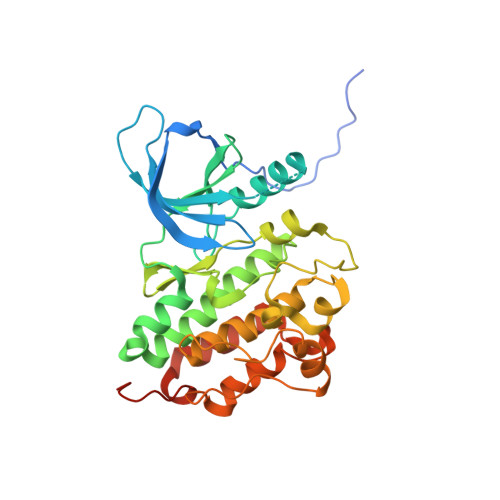6-Ethynylthieno[3,2-d]- and 6-ethynylthieno[2,3-d]pyrimidin-4-anilines as tunable covalent modifiers of ErbB kinases.
Wood, E.R., Shewchuk, L.M., Ellis, B., Brignola, P., Brashear, R.L., Caferro, T.R., Dickerson, S.H., Dickson, H.D., Donaldson, K.H., Gaul, M., Griffin, R.J., Hassell, A.M., Keith, B., Mullin, R., Petrov, K.G., Reno, M.J., Rusnak, D.W., Tadepalli, S.M., Ulrich, J.C., Wagner, C.D., Vanderwall, D.E., Waterson, A.G., Williams, J.D., White, W.L., Uehling, D.E.(2008) Proc Natl Acad Sci U S A 105: 2773-2778
- PubMed: 18287036
- DOI: https://doi.org/10.1073/pnas.0708281105
- Primary Citation of Related Structures:
2R4B - PubMed Abstract:
Analysis of the x-ray crystal structure of mono-substituted acetylenic thienopyrimidine 6 complexed with the ErbB family enzyme ErbB-4 revealed a covalent bond between the terminal carbon of the acetylene moiety and the sulfhydryl group of Cys-803 at the solvent interface. The identification of this covalent adduct suggested that acetylenic thienopyrimidine 6 and related analogs might also be capable of forming an analogous covalent adduct with EGFR, which has a conserved cysteine (797) near the ATP binding pocket. To test this hypothesis, we treated a truncated, catalytically competent form of EGFR (678-1020) with a structurally related propargylic amine (8). An investigation of the resulting complex by mass spectrometry revealed the formation of a covalent complex of thienopyrimidine 8 with Cys-797 of EGFR. This finding enabled us to readily assess the irreversibility of various inhibitors and also facilitated a structure-activity relationship understanding of the covalent modifying potential and biological activity of a series of acetylenic thienopyrimidine compounds with potent antitumor activity. Several ErbB family enzyme and cell potent 6-ethynyl thienopyrimidine kinase inhibitors were found to form covalent adducts with EGFR.
Organizational Affiliation:
Department of Assay Development, GlaxoSmithKline, Research Triangle Park, NC 27709, USA.















